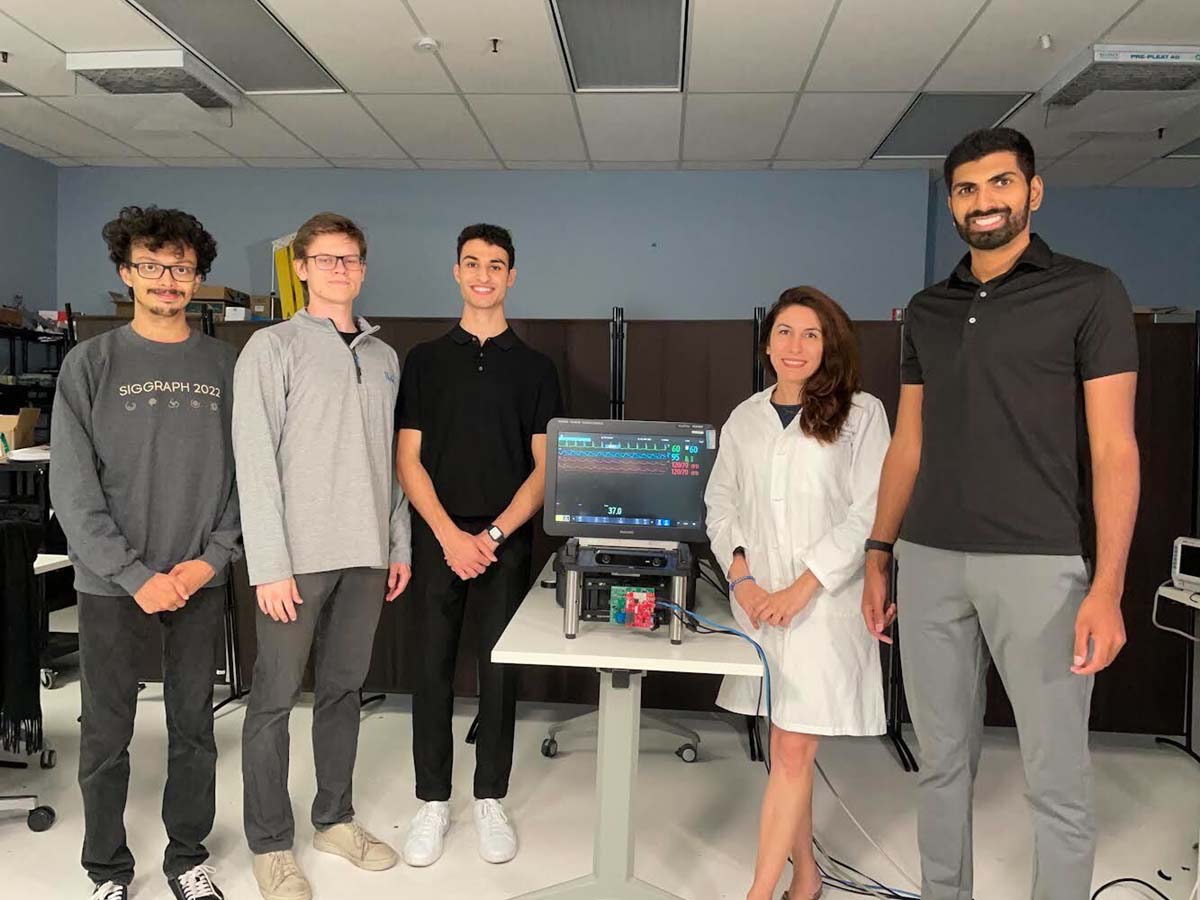UCLA Visual Machines Group develops biosensor that could eliminate racial bias

Researchers from the UCLA Visual Machines Group stand with their contactless heart rate sensor. The researchers created this sensor to eliminate racial bias in certain camera-based sensors. (Courtesy of Achuta Kadambi)

By Megan McCallister
Sept. 29, 2022 10:43 p.m.
Researchers from the UCLA Visual Machines Group created a new contactless biosensor technology that eliminates the racial bias found in some current sensors.
Biosensors are devices that measure chemical and biological reactions, such as vital signs. Amid the telehealth boom prompted by the COVID-19 pandemic, contactless biosensors came under scrutiny – and some fell short of medical standards.
One of these flawed sensors is the light-based heart rate detector, which the Visual Machines Group discovered is less accurate for people of color, said Achuta Kadambi, an assistant professor of electrical and computer engineering and co-author of the study.
The light-based heart rate sensor uses a camera, which extracts data from subtle changes in the color of a face that occur with each heartbeat.The cameras fail to properly perceive these color changes in darker skin tones, Kadambi said.
Melanin – a skin pigment more prevalent in darker skin – can potentially interfere with the signal sensed by the camera, said Dr. Jeff Hsu, a cardiologist at Ronald Reagan UCLA Medical Center.
The camera-based technology is common in devices that collect health data, including phones and wearable sensors, such as the Apple Watch or Fitbit, Hsu said, adding that he was surprised to hear about the bias in measurements recorded by devices he uses every day in his practice.
“It really just begs the question as to what else may be giving us inaccurate information. … It’s just an important question that we need to continually examine,” Hsu said.
Led by Kadambi and Dr. Laleh Jalilian, an anesthesiologist at the medical center and co-author of the study, the Visual Machines Group created a new contactless heart rate sensor that produces more accurate measurements for all skin tones. Combining the conventional light-based technology with a radio-based technology compensated for the bias in the measurements produced by the original sensor, Kadambi said.
In the Visual Machines Group’s sensor, the radar works by sending out a specific frequency of electromagnetic wave that reflects off the chest and back to the radar, said Alexander Vilesov, a doctoral student in electrical and computer engineering and co-author of the study. The heartbeat causes small vibrations in the chest that slightly shift the wave – and these shifts are detected by the radar, he added.
While the camera and radar used in the sensor are not new, the researchers created software that combines the data from these two technologies simultaneously, said Pradyumna Chari, a doctoral student in electrical and computer engineering and co-author of the study.
While the camera alone will not perform with equal accuracy for people of color, adding the radar alongside the camera provides equitable measurements, according to the research.
This new heart rate sensor is not ready to be used in the health care system as of now, Kadambi said. In the meantime, the theoretical concept of combining the two sensor systems can serve as a basis for a new generation of biosensors and has broad applications within and beyond the medical field.
“Imagine you’re in an area where there’s a search and rescue operation, maybe somebody is stranded, or if somebody is maybe in some rubble because the building has collapsed,” Kadambi said. “Maybe it’s possible to start using contact-free sensors at different penetration wavelengths to see if they can extract the heartbeat signatures of survivors.”
Jalilian said the device could also be advantageous in hospital settings to treat infectious diseases and other cases which require contactless patient care.
To become commonplace in hospitals, the device will need to be economically accessible and sell at a similar price to current heart rate sensors, Hsu said.
In addition to race, there are many other biases – including body mass index, sex and age – to consider when creating a device that works effectively for everyone, Vilesov said. As they continue to develop contactless sensors, the Visual Machines Group plans to prioritize equity, he added.
“This is just scratching the surface of moving towards more inclusive health devices,” Kadambi said. “Even looking more broadly … (at) a vast variety of sensors for human computer interaction, like the soap dispensers and automated faucets, that actually have similar issues.”

